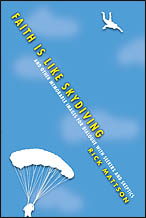
Many books on apologetics do well with the arguments, but have little on how to present them. Faith Is Like Skydiving combines reason with rhetoric, clarity with intellectual depth. It provides a vast array of arguments and a host of images to make those arguments clear and compelling. Intellectually sound and amazingly practical, this terrific book deserves widespread reading. — James Sire, author of The Universe Next Door: A Basic Worldview Catalog and guest contributor to the Emerging Scholars Network (ESN) Blog.
Introduction
As you may remember, I recently interviewed Rick Mattson regarding his new InterVarsity Press (IVP) release Faith Is Like Skydiving: And Other Memorable Images for Dialogue with Seekers and Skeptics. Rick serves with InterVarsity Christian Fellowship — following the Lord’s call to strengthen and encourage Christian students and faculty in their faith, and invite seekers and skeptics to consider Christ for their lives. I particularly appreciate his commitment to compassion, reason, and respect in his interactions with both “friend and foe” on campus. I wish that I had more opportunity to talk with Rick about the great questions of life! If you haven’t already done so I encourage you to read/share his resource rich ESN Blog series Headed to Graduate School.
Thank-you to IVP for this excerpt from Chapter 1 — where Rick engages the reader with how “faith is like skydiving”. Let’s dive in!
Evidential Stage Image: Skydiving
 Certain stories have incredible staying power in my mind, such as an account told to me many years ago by a woman whose husband died in a skydiving accident. I don’t even remember her name (or his), but I’ve no problem recalling the details of the tragedy. It was in Florida. He leapt from a plane on a windy day, spiraled downward, pulled the ripcord, dangled under a full chute, appeared to be coming in for a soft two-point landing—but got entangled in power lines.
Certain stories have incredible staying power in my mind, such as an account told to me many years ago by a woman whose husband died in a skydiving accident. I don’t even remember her name (or his), but I’ve no problem recalling the details of the tragedy. It was in Florida. He leapt from a plane on a windy day, spiraled downward, pulled the ripcord, dangled under a full chute, appeared to be coming in for a soft two-point landing—but got entangled in power lines.
The image of skydiving illustrates the evidential stage of faith for several reasons. One is the risk of failure, as the above story illustrates.
How could faith possibly fail? Easy. If you place your faith in the wrong thing, it fails. After all, it’s logically possible that Christianity is false and another worldview, such as Judaism or atheism, is true. And even though I may affirm the person whose faith comes naturally without much evidential support, it’s only fair to acknowledge that such faith could in fact be misplaced.
I once asked a Mormon missionary how he knew his faith was true. He replied that when he was reading the Book of Mormon, God spoke to his heart, and he thus came to believe in the Mormon religion. This is sometimes called a “burning of the bosom,” a sense that God is revealing himself through the Mormon scriptures. I pressed the matter further. How did he know it was actually God speaking to him and not some other spiritual being or even his own imagination? He just knew. But how? He’d simply opened his heart to the truth of the scriptures and now he was one hundred percent convinced. But—

You see the dilemma of a faith-only approach to truth, which is sometimes called “fideism” by scholars. Choosing the correct object of faith is the crucial thing. I’ve met people of all different religions (not to mention the irreligious) who hold their beliefs in a natural, organic, almost effortless way. It hardly occurs to them that their views could be false. Yet they cannot all be true. Religions such as Christianity, Mormonism, Judaism and Buddhism make statements about reality that are in direct conflict with each other. For example, the Christian understanding of God as Trinity disagrees with the other religions just mentioned. Logically, someone (or everyone) is off base here.
But it’s not just fideism that can fail. Those of us who work hard at the evidential part of faith have no guarantees that our cognitive pursuits will pay off. We can be tragically caught in the power lines of intellectualism. We can mishandle arguments, misinterpret data or cave in to our prejudices and wishful thinking. The supposed objective “court of law,” which is our mind’s judge and jury, may not function properly. When we jump out of the airplane of faith, faulty thinking can land us in the wrong spot.
Still, I’ll take my chances with the evidence. To me there’s nothing like thoroughly investigating a case for something before believing its claims. That’s why I’ve spent the last three-plus decades asking the question of whether Christianity is true, digging through its historical, philosophical and experiential arguments. It’s been a fantastic course of study! Again, I absolutely do not want to hold to a position that is false.
And hey, did you know that skydiving is relatively safe? It’s easy to focus on the risk of failure, but what about the probabilities of success? Well, according to the U.S. Parachute Association, in 2010 only twenty-one fatalities occurred in its members’ estimated three million jumps. That’s a 99.993 percent safety record.
Before I’d ever jump out of an airplane, I’d read all the safety statistics and interview seasoned jumpers and check out every single piece of high-tech gear twice. That process is what I call the evidential part of skydiving. You look before you leap. You calculate the risks. And even though the evidence falls short of the high standard of proof, it’s still pretty convincing (20-21). . . .

Tom enjoys daily conversations regarding living out the Biblical Story with his wife Theresa and their four girls, around the block, at Elizabethtown Brethren in Christ Church (where he teaches adult electives and co-leads a small group), among healthcare professionals as the Northeast Regional Director for the Christian Medical & Dental Associations (CMDA), and in higher ed as a volunteer with the Emerging Scholars Network (ESN). For a number of years, the Christian Medical Society / CMDA at Penn State College of Medicine was the hub of his ministry with CMDA. Note: Tom served with InterVarsity Christian Fellowship / USA for 20+ years, including 6+ years as the Associate Director of ESN. He has written for the ESN blog from its launch in August 2008. He has studied Biology (B.S.), Higher Education (M.A.), Spiritual Direction (Certificate), Spiritual Formation (M.A.R.), Ministry to Emerging Generations (D.Min.). To God be the glory!

Leave a Reply